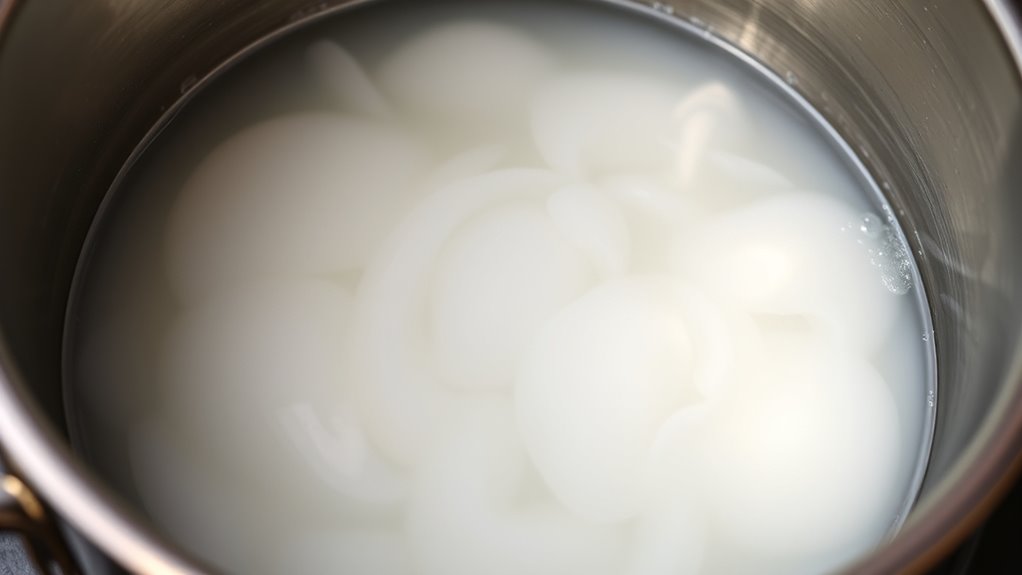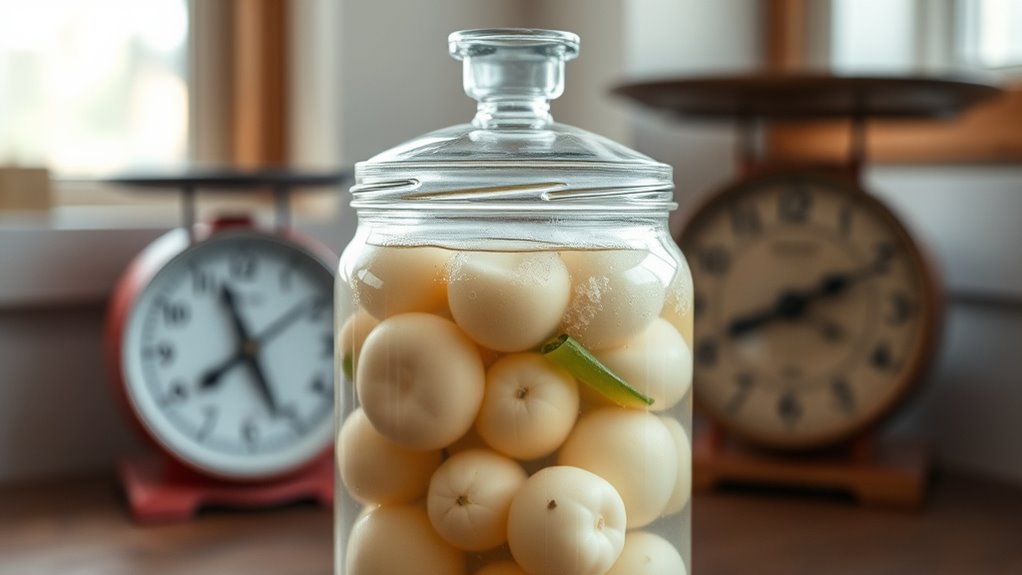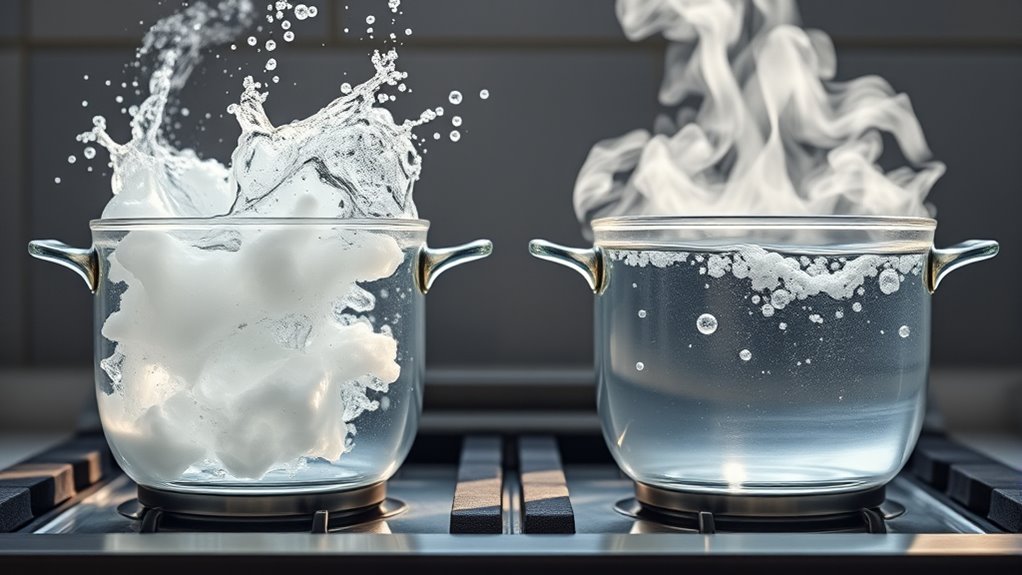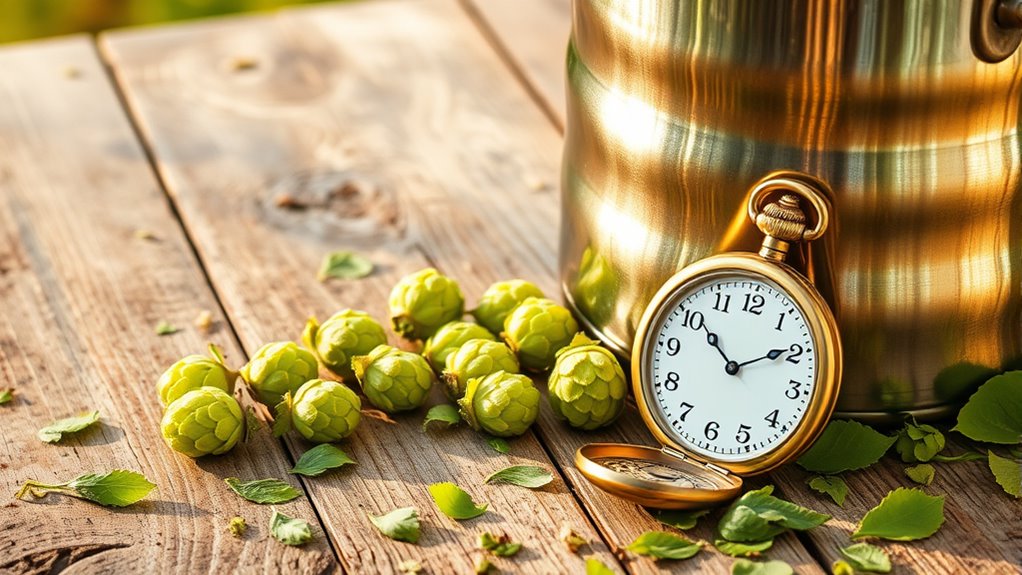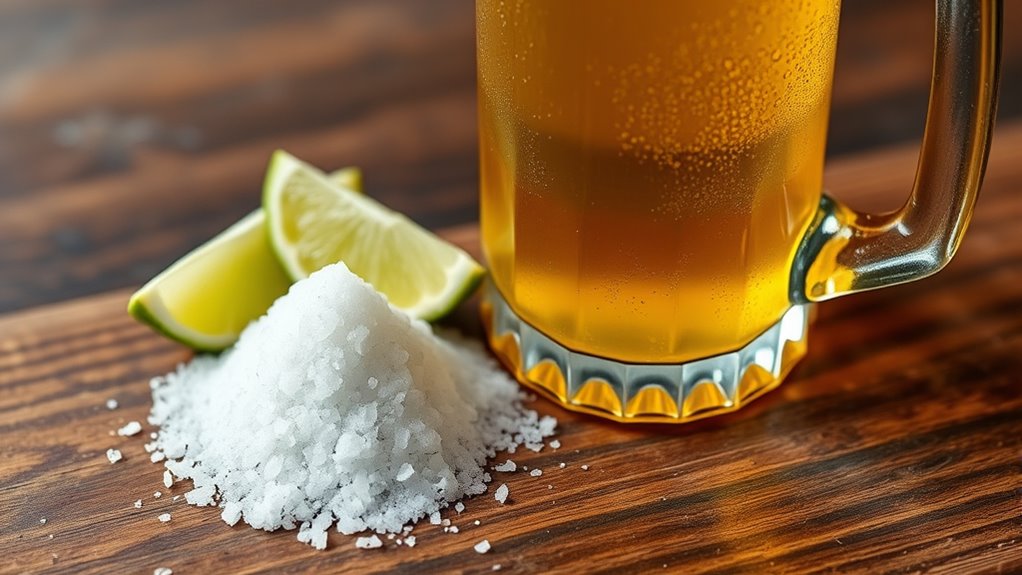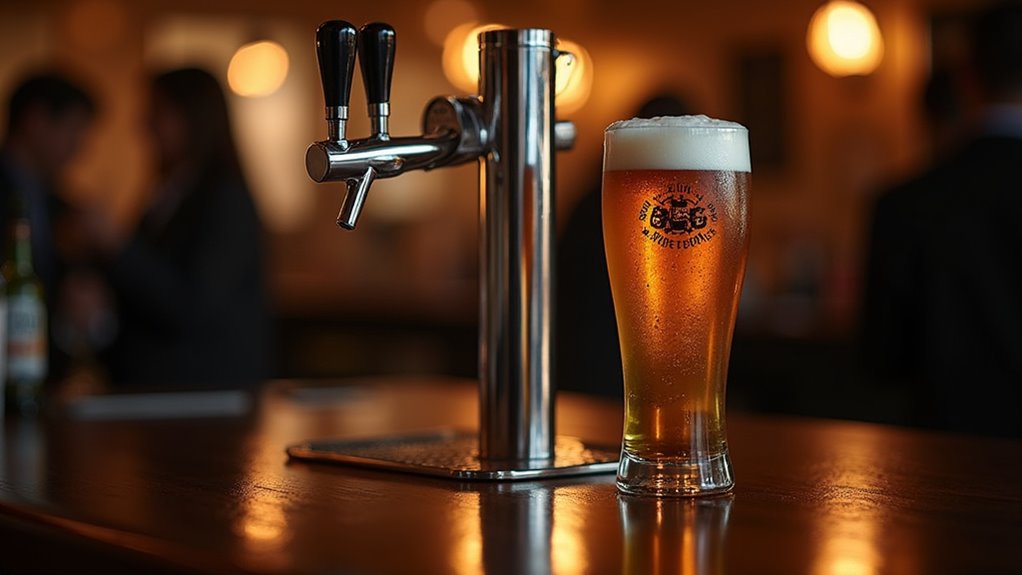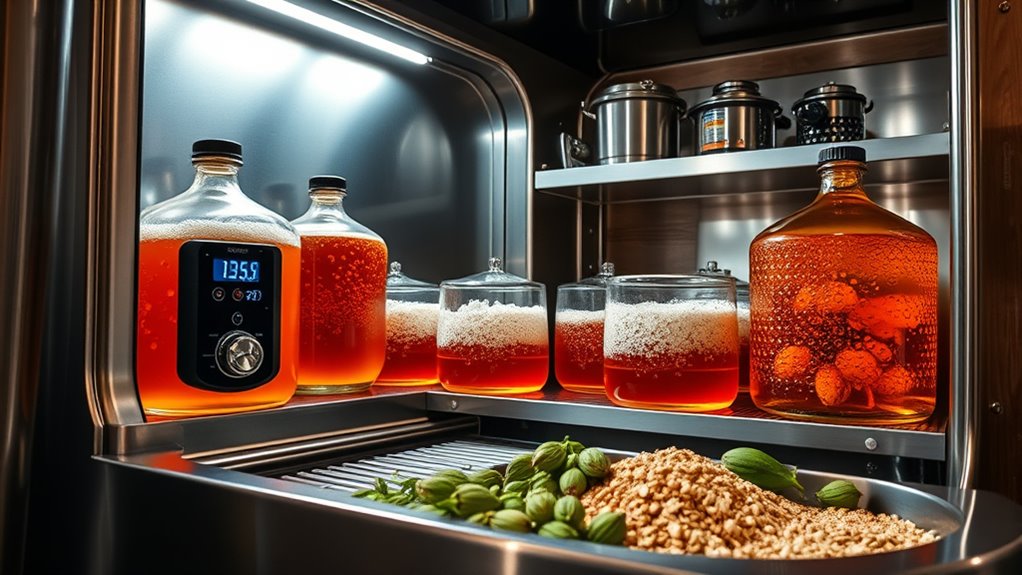Hot break timing is vital in brewing because proteins coagulate during the boil around 10 to 30 minutes in. This process enhances clarity and stability, as larger clumps form, improving your beer’s final quality. To achieve ideal results, maintain a vigorous boil for at least 60 minutes and consider using boil finings like Irish moss near the end of the boil. Understanding these factors can greatly enhance your brewing process. Explore further to discover additional tips and techniques.
At a Glance
- Hot break formation occurs between 10 to 30 minutes into the boiling process.
- A vigorous boil promotes effective protein denaturation and coagulation.
- Maintaining consistent kettle temperature enhances the hot break process.
- Adding boil finings like Irish Moss helps improve coagulation during the last 10-15 minutes.
- A boil duration of at least 90 minutes is recommended for optimal hot break development.
Understanding Hot Break
The process of hot break is crucial for brewing quality beer, as it directly impacts the clarity and stability of the final product.
During the boil, proteins in the wort undergo coagulation, forming larger clumps that precipitate out. This typically happens 10 to 30 minutes into the boil. You’ll notice foam formation ceases, signaling successful protein bonding.
To enhance hot break, consider adding Irish moss or other boil finings during the last 10-15 minutes. This promotes further coagulation and improves clarity by aiding in the removal of unwanted particulates.
Achieving a solid hot break is essential for a clear, stable final beer. Additionally, maintaining consistent brew kettle temperature during this phase can further enhance the coagulation process, leading to improved clarity and flavor stability.
Helpful Hints:
- Monitor boil time for ideal hot break.
- Use Irish moss for enhanced clarity.
- Observe foam formation for visual cues.
The Role of Proteins in Brewing
Understanding the role of proteins in brewing is essential for producing quality beer. Proteins found in grains like barley and wheat contribute to mouthfeel and head stability.
During boiling, proteins undergo denaturation, unfolding and bonding to facilitate coagulation, resulting in hot break. This process clumps proteins, allowing for their removal from boiling wort, which enhances clarity and reduces haze.
Additionally, managing protein levels is vital for flavor stability, as certain proteins enhance aroma while others may cause unwanted haze. By optimizing boiling duration, you can improve protein precipitation, leading to a more refined final product. Maintaining a proper mash pH is also crucial, as it influences the overall flavor profile of the beer.
Helpful Hints:
- Maintain a boil of at least 90 minutes.
- Monitor protein levels for flavor balance.
- Remove hot break for clearer beer.
Coagulation and Clarity
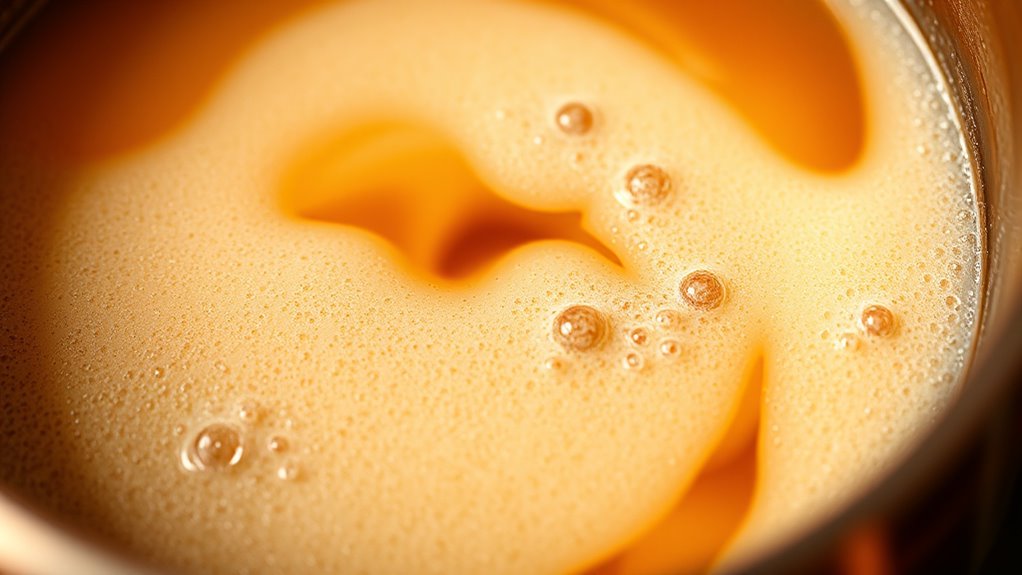
Coagulation plays an essential role in determining the clarity of your beer. During the boiling process, proteins denature and coagulate, forming what’s called hot break. This occurs 10 to 30 minutes into the boil, allowing proteins to clump and trap particulates.
The result? A clearer wort. While skimming hot break foam can enhance clarity—particularly in lighter beer styles—studies show that removing it doesn’t greatly impact beer quality. Proper sanitization of brewing equipment before each batch also contributes to overall beer quality by preventing contamination.
Understanding this relationship between coagulation and clarity helps you innovate in your brewing, ensuring your final product not only looks great but meets your desired standards for quality.
Understanding how coagulation affects clarity empowers brewers to elevate their craft and achieve exceptional quality in every batch.
Helpful Hints:
- Monitor hot break formation closely.
- Skim to improve clarity if desired.
- Experiment with various beer styles for best results.
Timing of Hot Break Formation
When you boil your wort, the timing of hot break formation is critical to attaining a clear and stable beer. Typically, this process occurs between 10 to 30 minutes into the boiling process. During this time, proteins coagulate, leading to protein precipitation and the formation of foam.
To enhance clarity, aim for a boil duration of at least 90 minutes, promoting thorough protein and tannin removal. Rapidly heating your wort also aids in achieving an effective hot break. Achieving a vigorous boil helps ensure that the proteins are efficiently removed for optimal clarity.
Remember, proper timing not only influences clarity but also impacts the overall quality of your beer.
Helpful Hints:
- Monitor boil duration closely.
- Facilitate rapid heating for ideal results.
Factors Influencing Hot Break
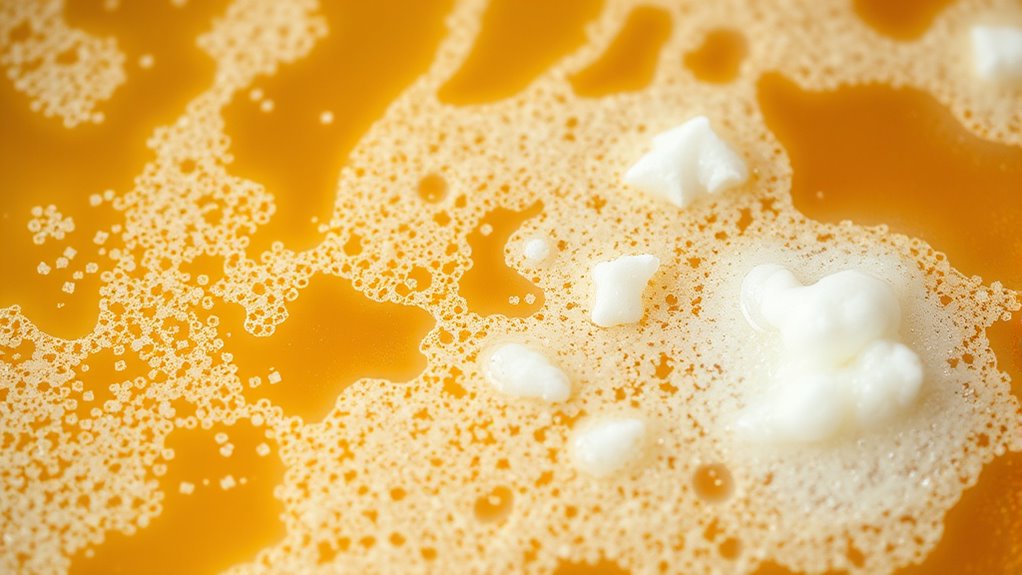
While many factors can influence the formation of hot break, the composition of your wort plays a significant role. The types and amounts of grains you use determine the levels of proteins and polyphenols present, which directly affect coagulation.
A vigorous boil is essential, as it promotes protein denaturation, removing impurities effectively. Additionally, temperature management is vital; rapid heating can enhance hot break, but excessive heat might introduce off-flavors. Maintaining a stable temperature during boiling can also prevent temperature fluctuations that may affect the overall brewing process.
Including Irish moss can also aid in coagulation. Pay attention to boiling temperature and maintain a steady, vigorous boil for best results in your brewing process.
Helpful Hints
- Monitor grain types.
- Control boiling intensity.
- Consider using Irish moss.
Effects on Beer Quality
The formation of hot break plays an important role in determining the quality of your beer, especially regarding clarity and stability.
During boiling, proteins coagulate, reducing unwanted proteins that can cause haze. This process enhances the visual appeal of the final beer, creating a clearer product.
While studies show that removing hot break doesn’t noticeably alter flavor, mouthfeel, or aroma, effective hot break formation is vital for lighter beer styles.
Proper boiling techniques and the use of boil finings can improve protein clumping, resulting in better clarity and overall beer quality. Additionally, thorough cleaning and sanitizing of brewing equipment prior to the boiling process can further enhance the effectiveness of hot break formation.
Helpful Hints:
- Boil vigorously for ideal hot break.
- Consider using boil finings for clarity.
Techniques for Managing Hot Break
Managing hot break effectively is important for achieving the best possible beer clarity and quality. To optimize the boiling process, maintain a vigorous boil, allowing proteins to coagulate properly.
Effectively managing hot break is crucial for achieving optimal beer clarity and quality through a vigorous boiling process.
Consider adding brew finings like Irish Moss or Whirlfloc in the final 10-15 minutes to enhance protein denaturation and improve wort clarity. Skimming the hot break foam reduces protein content, which is particularly beneficial for lighter beer styles.
Additionally, employing first wort hopping and utilizing a hop spider can enhance wort circulation, minimize clogging, and boost brewing efficiency. These techniques will help guarantee a cleaner, more refined final product. Decoction mashing, with its promotion of enzymatic activity, can also enhance clarity and flavor development during the brewing process.
Helpful Hints:
- Maintain a consistent boil.
- Use brew finings wisely.
- Don’t skip skimming the foam.
- Utilize first wort hopping for better efficiency.
- Consider a hop spider for filtration.
Comparison of Hot and Cold Break
Understanding the differences between hot break and cold break is essential for any aspiring brewer.
Hot break occurs during the boiling process, when proteins in the wort coagulate, forming clumps that rise to the surface. This process enhances flavor, stability, and clarity by removing unwanted proteins.
In contrast, cold break forms after boiling through rapid cooling, leading to further protein settling that also aids clarity.
Both breaks contribute to the beer’s quality, but while hot break mainly influences flavor and stability, its removal doesn’t considerably affect sensory qualities. Proper cold conditioning techniques can also enhance the clarity and flavor profile of the final product.
Mastering both techniques guarantees a cleaner, more refined final product.
Helpful Hints:
- Monitor boiling time for effective hot break.
- Chill wort quickly for ideal cold break.
Practical Brewing Tips
When you immerse yourself in brewing, knowing practical tips can greatly enhance your process and results.
1. Maintain a Vigorous Boil****
A consistent rolling boil for at least 60 minutes is critical for effective hot break formation, allowing proteins to coagulate and improving clarity in your wort.
2. Use Boil Finings****
Add boil finings like Irish Moss or Whirlfloc during the last 10-15 minutes to enhance protein clumping.
3. Skim the Foam****
Regularly skimming hot break foam reduces protein content, especially beneficial for lighter beer styles.
4. Rapid Chilling****
Quickly chill your wort after boiling to promote cold break, further enhancing clarity and flavor stability. Additionally, maintaining a proper mash temperature can influence the overall flavor and body of your beer.
Future Research Directions
Exploring future research directions in brewing offers exciting possibilities for improving beer quality and consistency.
You might want to investigate how hot break removal impacts proteins coagulation, influencing beer clarity and stability.
Additionally, examining various hop varieties and their addition timing could optimize flavor profiles.
Exploring hop varieties and their timing can significantly enhance the flavor profiles of your brews.
Advanced boiling techniques, like high-pressure boiling, warrant exploration to enhance beer quality.
Evaluating yeast performance during fermentation in relation to trub composition will deepen your understanding of overall beer character.
Finally, conducting blind taste tests with diverse beer styles can yield valuable insights into the sensory effects of hot break removal on perceived beer quality. Incorporating insights from barrel aging techniques could also reveal how different aging methods affect flavor complexity in relation to hot break management.
